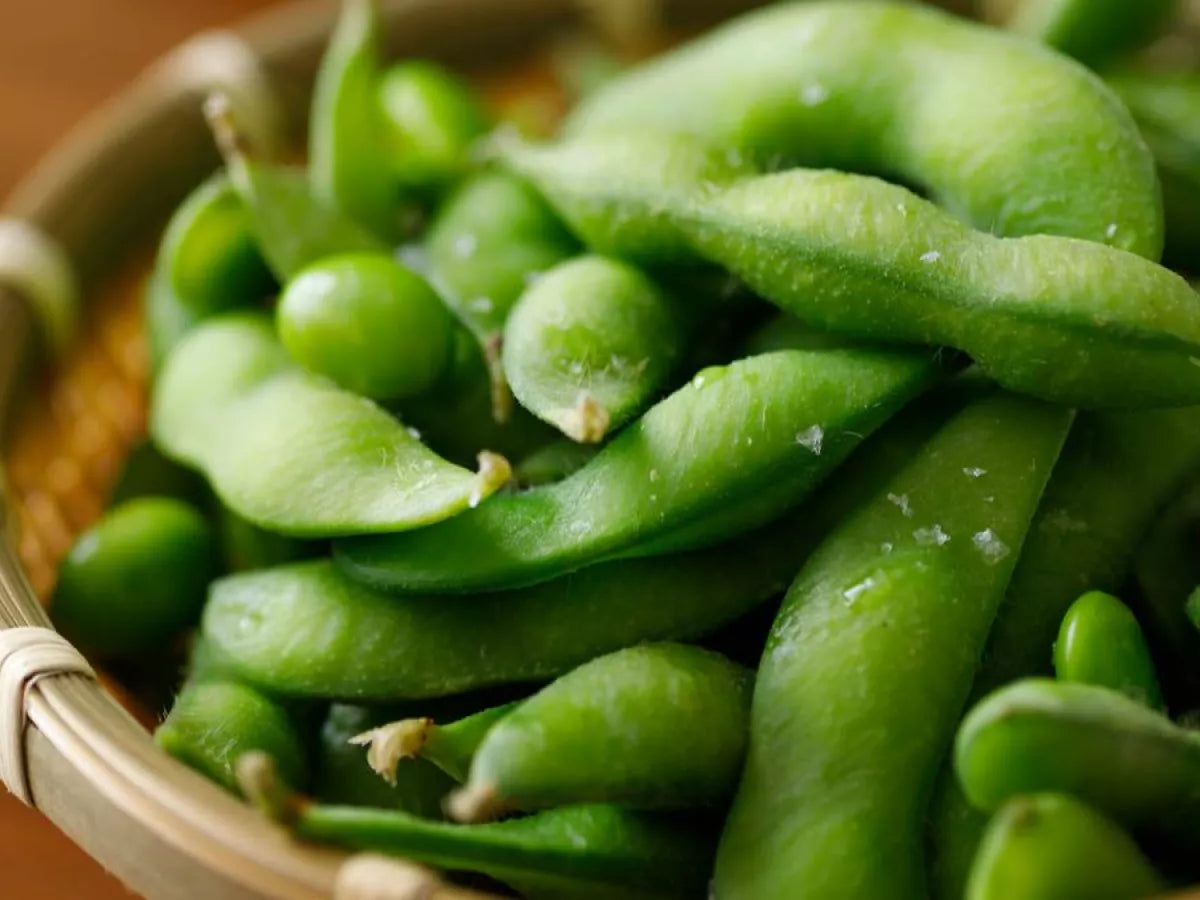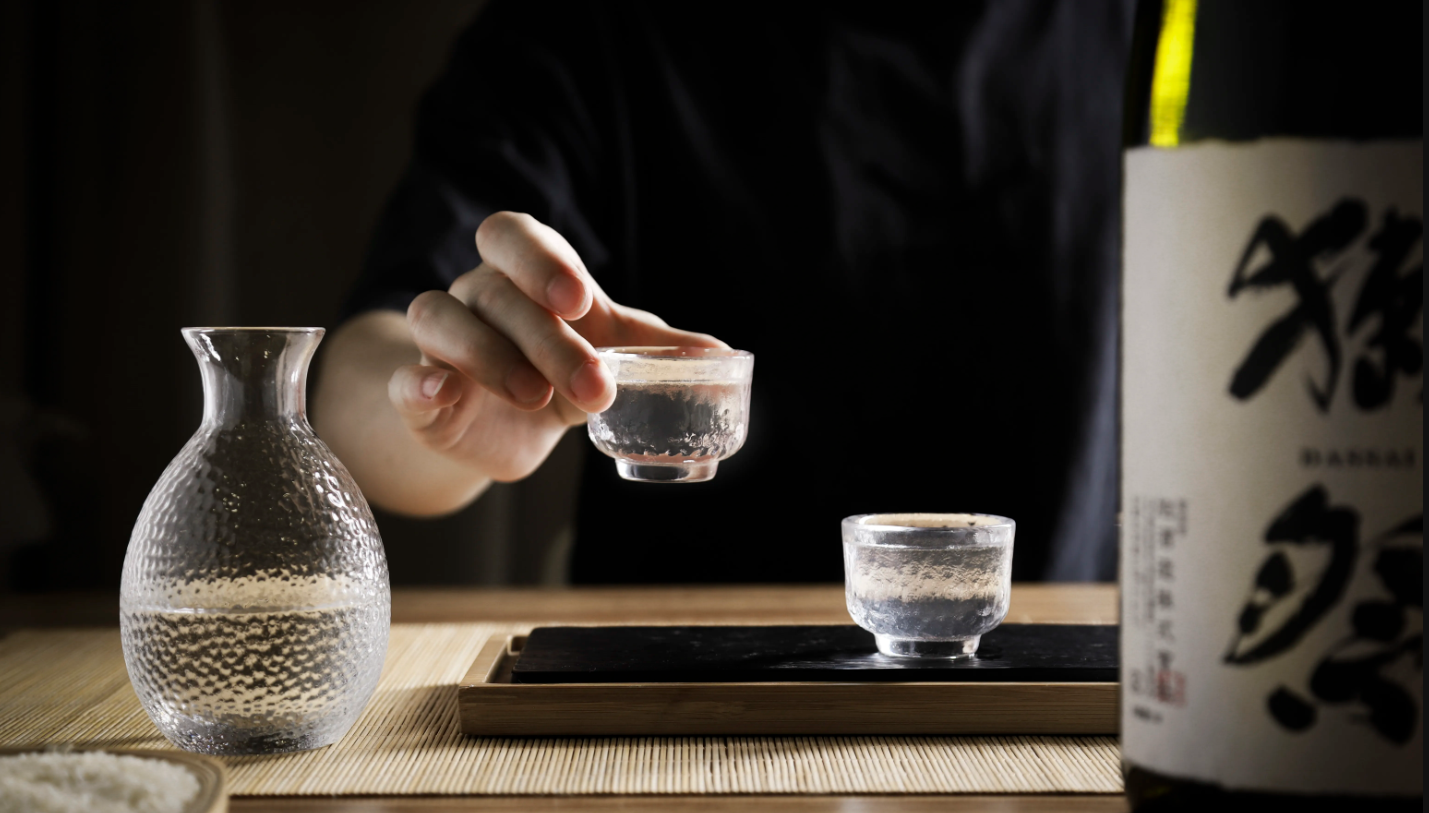Edamame is the Japanese name for young soybeans, and is a staple in Asian cuisine. It is harvested before the beans have ripened or hardened. This food can be found in several forms: shelled, in the pod, fresh or frozen.
This delicious appetizer is more than just a tasty addition to your meal. Edamame is a complete protein source, meaning it provides all the essential amino acids your body needs. Plus, it's naturally gluten-free, low in calories, and contains no cholesterol. These characteristics make edamame a healthy option to incorporate into your diet.
But the benefits of edamame don't stop there. It is also an excellent source of iron and calcium, two minerals that play a crucial role in the body's health. Iron is vital for the production of red blood cells, while calcium is essential for bone health.
Do you want to know more health benefits of edamame? Continue reading!
Origin and Popularity in Japan
Edamame, whose name literally means " vine bean " in Japanese, originates in East Asia, and has become a staple of the Japanese diet for centuries. The popularity of edamame in Japan is immense, so much so that this small green bean has become a cultural icon.
In Japan, edamame is mainly consumed as a snack; simply boiled in salted water and served still in its pod. It is common to find this appetizer in bars and restaurants, especially in izakayas, Japanese tapas bars, where it is often served along with a beer.
Edamame is also found in many Japanese dishes, from soups and salads to rice dishes. In addition, its freshness and mild flavor make it an excellent accompaniment to summer meals, especially outdoor barbecues.
The popularity of edamame in Japan is due not only to its delicious taste and versatility in cooking, but also to its numerous health benefits. This humble bean is a complete protein source, meaning it provides all the essential amino acids. Plus, it's low in calories and gluten-free, making it a healthy option for almost any diet.
Nutrition
The table below shows the nutrients one cup of shelled edamame provides and how much of these nutrients an adult needs per day for comparison.
Some requirements vary depending on the age and sex of the person.
| Nutrient | Amount in a cup of 160 grams (g) of cooked edamame beans | Recommended daily intake (adult) |
|---|---|---|
| Energy (calories) | 224 | 2,000–3,000, depending on age, sex, and activity level |
| Protein (g) | 18.4 | 46–56 |
| Carbohydrates (g) | 13.8 (3.38 sugar) | 130 |
| Fiber (g) | 8 | 28–34 |
| Iron (mg) | 3.52 | 8–18 |
| Calcium (mg) | 97.6 | 1,000–1,300 |
| Magnesium (mg) | 99.2 | 130–420 |
| Phosphorus (mg) | 262 | 700–1,250 |
| Potassium (mg) | 675 | 2,600–3,400 |
| Zinc (mg) | 2.13 | 5–11 |
| Selenium (mcg) | 1.28 | There is no data |
| Vitamin C (mg) | 8.48 | 75–90 |
| Folate (mcg) | 458 | 200–400 |
| Choline (mg) | 87.5 | 250–550 |
| Vitamin A, RAE (mcg) | 40 | 400–900 |
| Beta carotene (mcg) | 278 | There is no data |
| Vitamin K (mcg) | 45.1 | 60–120 |
| Lutein + zeaxanthin (mcg) | 2,510 | There is no data |
Benefits
Consumption of soy foods, such as edamame, has been associated with a lower risk of various diseases and improvements in overall health. Below we present some of the most notable benefits.
- Age-related brain diseases: Studies suggest that consumption of soy isoflavones may reduce the risk of cognitive decline. Although some findings are conflicting, a 2015 review concluded that soy isoflavones may help improve cognitive function after menopause.
- Cardiovascular disease: There is evidence that soy protein has properties that can lower levels of low-density lipoprotein (LDL), or "bad" cholesterol, in the blood. Additionally, soy may benefit cardiovascular health through its fiber content, antioxidants, and other mechanisms.
- Breast and prostate cancer: There has been controversy about the effect that soy may have on breast cancer risk. However, according to the American Cancer Society, evidence does not suggest that soy products increase the risk of breast cancer or other types of cancer. In fact, it was found that consumption of soy products can significantly reduce the risk of prostate cancer in men and offer protection against breast cancer.
- Depression: Edamame contains folate, which the body needs to make DNA and for proper cell division. Some research has linked low folate levels to depression.
- Diabetes: People with type 2 diabetes may benefit from consuming unsweetened soy products, such as edamame, according to a 2012 study. A 2018 review also concluded that consuming soy products may help reduce the risk of diabetes type 2.
- Fertility: Edamame is a good source of iron, folate, and plant-based proteins, which may promote fertility or reduce the risk of ovulation disorders.
- Energy levels: Lack of iron in the diet can affect how the body uses energy and lead to iron deficiency anemia. Edamame is an excellent source of non-heme iron.
- Inflammation: A 2012 study found that, among 1,005 Chinese women, those who consumed more soy products had lower levels of inflammatory markers in their blood than those who did not.
- Menopause-related problems: The estrogen-like action of soy isoflavones may help alleviate the impact of two aspects of menopause.
In conclusion, edamame is a superfood that offers a wide variety of health benefits. Whether you're looking to improve your nutrition, prevent chronic diseases, or simply enjoy a delicious snack, edamame is definitely an option to consider.
How to prepare and cook Edamame
Preparing and cooking edamame is a fairly simple process that will allow you to enjoy this healthy legume in a variety of dishes. Here we present some techniques and suggestions so that you can do it in the best way.
Preparation of Edamame
If you bought fresh edamame, simply rinse it well before cooking. If you opted for frozen edamame, you don't need to defrost it; you can cook it directly.
How to Cook Edamame
- Boiling : This is the most common technique for cooking edamame. Add the edamame to a pot of boiling water with a little salt and cook for about 5-6 minutes. Then, drain it and let it cool slightly before eating it.
- Steamed : If you have a steamer, you can steam the edamame for about 15-20 minutes.
- In the microwave : If you're short on time, you can also cook edamame in the microwave. Place the edamame in a microwave-safe bowl, add a little water, and cover the bowl. Cook on maximum power for 2-3 minutes. Be careful when removing the cover, as the steam released can be very hot.
No matter which cooking method you choose, it is advisable to season the edamame with a little sea salt after cooking. If you want to give it a more exotic touch, you can also use spices such as paprika, garlic powder or even sprinkle a little grated cheese on top.
Plus, edamame is a delicious and nutritious addition to salads, soups, stews, and scrambles. You can also make edamame hummus by simply mashing it with a little olive oil, garlic, lemon juice, and tahini.
In short, edamame is a versatile and healthy food that can be prepared in many ways. Don't hesitate to experiment and find the way you like best to enjoy this legume.
What does Edamame taste like?
Edamame has a unique flavor that can be hard to describe if you've never tried it before. However, here is an overview of what you can expect.
The flavor of edamame can be described as slightly sweet and buttery, with a hint of nuttiness. It is softer than other legumes, such as peas, but has a firm, slightly crunchy texture that makes it very satisfying to eat. Although the flavor is mild, it has a distinctive "green" or vegetal flavor that is very pleasant.
When cooked with salt, edamame can have a deliciously salty flavor that contrasts well with its natural sweetness. Some people also enjoy the flavor of edamame with additional spices, such as garlic, paprika, or chili, which can accentuate its natural flavor.
Edamame Recipes
1. Edamame sautéed with garlic and salt
Ingredients:
- 2 cups edamame (you can use fresh or frozen)
- 2 cloves garlic, minced
- 2 teaspoons olive oil
- Salt to taste
Instructions:
- Cook the edamame in boiling salted water for 5 minutes. If using frozen edamame, follow package directions.
- While the edamame is cooking, heat the olive oil in a skillet and add the minced garlic. Sauté the garlic until golden.
- Add the drained edamame to the pan with the garlic and stir well to blend the flavors.
- Season with salt to taste and serve hot.
2. Edamame and quinoa salad
Ingredients:
- 1 cup of quinoa
- 2 cups edamame
- 1 red bell pepper, diced
- 1 cucumber, diced
- 2 carrots, grated
- Lemon and olive oil dressing to taste
- Salt and pepper to taste
Instructions:
- Cook the quinoa according to package instructions and let it cool.
- Cook the edamame in boiling salted water for 5 minutes, then drain and let cool.
- In a large bowl, mix together the quinoa, edamame, bell pepper, cucumber and carrots.
- Add the lemon and olive oil dressing to taste, then season with salt and pepper.
- Toss the salad well and serve cold or at room temperature.
3. Edamame hummus
Ingredients:
- 2 cups edamame
- 2 cloves of garlic
- Juice of 1 lemon
- 1/4 cup tahini
- 1/4 cup olive oil
- Salt to taste
Instructions:
- Cook the edamame in boiling salted water for 5 minutes, then drain.
- In a food processor, combine the edamame, garlic, lemon juice, tahini, olive oil and salt.
- Process until smooth. If necessary, add a little water to obtain the desired texture.
- Serve the edamame hummus with pita bread, fresh vegetables or as a spread on sandwiches.
These recipes will allow you to enjoy edamame in varied and delicious ways. Enjoy!
Frequently asked questions
1. Can I eat edamame pods?
No, edamame pods are not intended to be eaten. They are too fibrous to be digested properly. Instead, you should open the pod and eat the soybeans inside.
2. Is it safe to eat raw edamame?
It is not recommended to eat raw edamame as it can be difficult to digest and may contain harmful bacteria. It is best to boil or steam edamame before consuming it.
3. Can edamame help you lose weight?
Edamame can be a good addition to a weight loss diet because of its high protein and fiber content, which can help you feel full and satisfied. However, as with any food, it is important to eat it in moderation.
4. Is edamame suitable for people with soy allergies?
No, edamame is a form of soy and is not safe for people with soy allergies.
5. Is edamame suitable for vegetarian and vegan diets?
Yes, edamame is an all-plant food and is an excellent source of protein for vegetarian and vegan diets.
6. Does edamame have estrogenic effects on the body?
Edamame contains isoflavones, a type of phytoestrogen that can act similarly to estrogen in the body. However, studies have not conclusively shown that edamame consumption has a significant impact on estrogen levels in the body.
7. Can edamame be part of a ketogenic diet?
Although edamame is low in carbs compared to other types of legumes, it may still be too high in carbs for those following a strict ketogenic diet. It is best to check your carbohydrate content and adjust intake based on your individual dietary needs.






Leave a comment
All comments are moderated before being published.
This site is protected by hCaptcha and the hCaptcha Privacy Policy and Terms of Service apply.